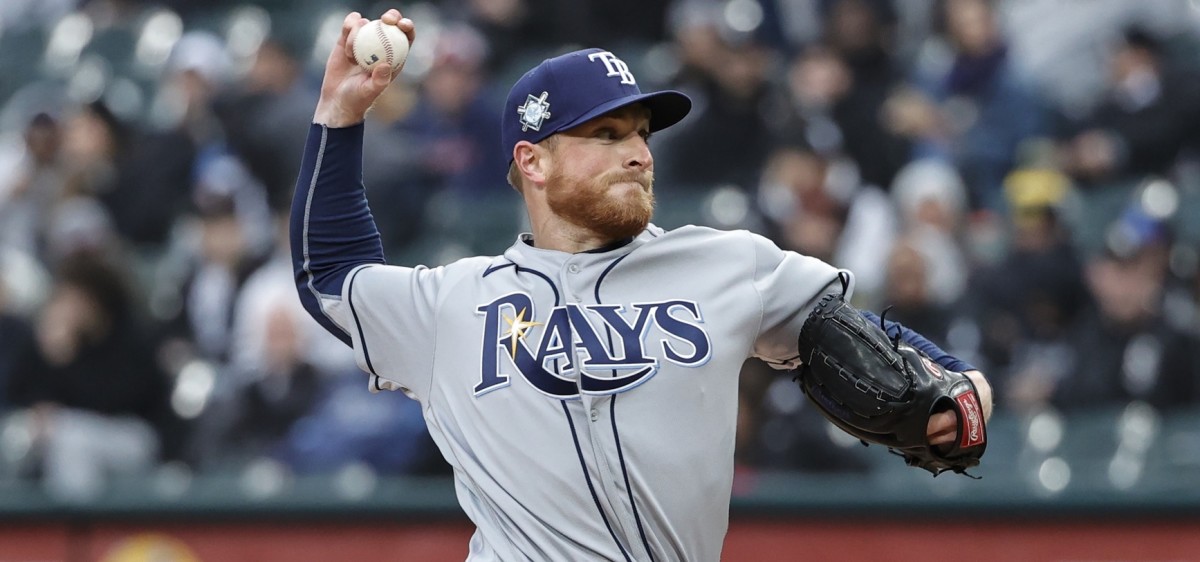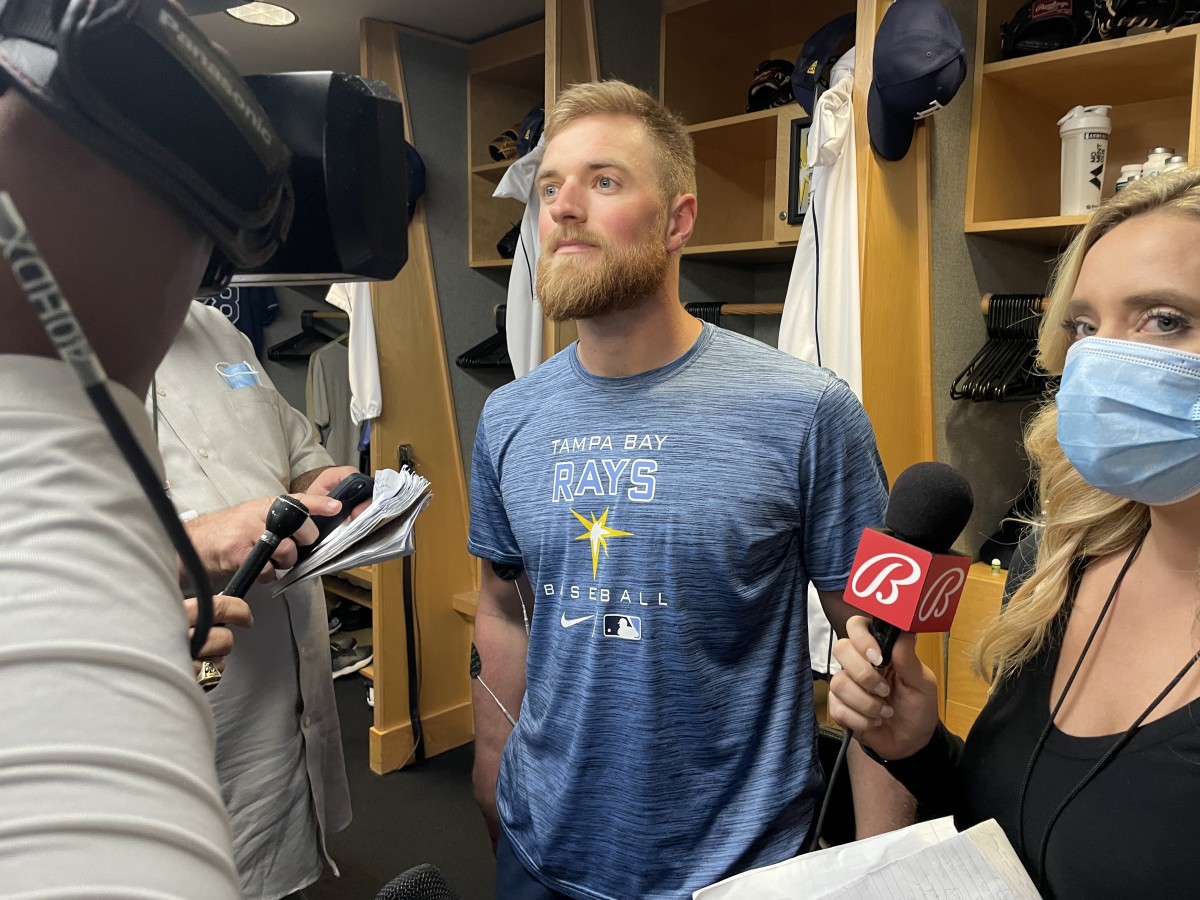Last Pitch to First: Behind The Scenes With Drew Rasmussen From One Start to Next

ST. PETERSBURG, Fla. — It's a strange life, being a major-league starting pitcher. It's one of the most important high-profile jobs in the game, and once you're done doing your thing on the mound for a couple of hours, the strangest thing happens.
You disappear from public view for five or six days.
And when your turn to pitch rolls around again, you do the same thing over and over. Everyone sees all the work on the mound during the games, but no one sees the dozens of hours of work in between starts.
We see and know all about what happens from the first pitch to the last. But what about from the last pitch to the first?
Tampa Bay Rays starter Drew Rasmussen was kind enough to put together a timeline for us on what happens from the time he walks off to mound to when he walks back on. He pitched on Wednesday, May 18, beating the Detroit Tigers. The Rays have had two days off since then — on Thursday and Monday — so Rasmussen got extra time to recover this time around, a rare luxury. He was going to get six days off between starts instead of the usual four.
Rasmussen didn't pitch again until last Wednesday night, when he started against the Miami Marlins. And with Rasmussen taking the mound again on Monday night in Texas — he's now 5-1 with a 2.68 ERA —, this is a good time to take you through his journey.
From last pitch to first.
Wednesday, May 18
It's a Wednesday afternoon at the ballpark and Drew Rasmussen is cruising. The Rays have won four of his starts in a row, and Rasmussen, the 26-year-old redhead from Spokane, Wash., is throwing another gem in the rubber game of a three-game series with the Detroit Tigers.
With two outs in the fifth inning, Rasmussen throws a slider low and away to Tigers right fielder Robbie Grossman and he hits a lazy fly ball to right field to end the inning. Rasmussen walks off the mound with a 4-0 lead.
When he gets to the Rays' first-base dugout, Tampa Bay manager Kevin Cash is waiting for him with hand outstretched, and that's the first sign.
Rasmussen's day is done. It's 2:52 p.m.
"I don't like coming out of games and they know that. So usually what happens is Cashy is already getting out ahead of that. So as soon I get to the dugout, he's shaking my hand and telling me 'you're done,' whenever that is.''
Rasmussen pitched five scoreless innings that day, allowing just four hits with no walks and seven strikeouts. It was an effective day, but there were several long at-bats that drove his pitch count up. He threw 87 pitches to get those 15 outs — ''way too many pitches for 15 outs,'' he said. So going back out for the sixth was out of the question, at least in Cash's mind.
Rasmussen stays in the dugout to watch the Rays bat in the bottom of the fifth. They go three up, three down, so at 3:05 p.m., he heads back into the clubhouse.
"Coming up with Milwaukee, you had to watch the next offensive half,'' Rasmussen said. "I like that and I still do it, because even if your day is done, you still want to be out there to support your teammates.
"Then I walk into the clubhouse and change out of the sweaty stuff, put on some shorts and a shirt and head straight to the training room and do some strengthening exercises right away for the shoulder, the scaps (shoulder joint), the forearms because A, they're already warmed up, but B, you want to get the blood flowing and start the recovery process. A lot of time that's just with dumbbells, and it's with an athletic trainer and they're adding resistance with their hands, too. From there, I'll hop on a Marc Pro (electronic muscle stimulator) just to get blood flowing, and get a flush on the arm, and the lat and the back a little bit, followed by 15-30 minutes in the sauna to sweat out some of that soreness, some of that lactic acid, and that's usually it for that day.''
And how does he feel when he's done on gameday?
"It kind of depends on the day,'' he said. "I've been fortunate throwing in Chicago and at the Trop and in Seattle, so I haven't thrown in any hot games. When it's hot, hot in the summer, you're just exhausted. And it's almost like an emotional release, that hey, your day is done.
"When you're in game and in the moment, you don't think about (the fatigue) at all, but the second it's over, you take a deep breath and there's some exhaustion for sure. I'm a high intensity guy, so how do I calm myself down, how do I get blood flowing to the arm and the scaps? I'll go through that whole routine and then I try to go home and sleep, but on game days, I never sleep very well, but that's almost always mental. Good game or bad, you're always going through everything and trying to think about what you can do better and what you can improve on.''
Because it was a day game, he was able to be home a bit after 6 p.m. and was able to spend time with his wife Stevie. "That is one of the pluses of day games, getting a little time at home and still getting a good night's sleep.''
Thursday, May 19 (Off day)
The Rays were off the next, Thursday, and because Monday was also an off day, Rasmussen knew that he would have six days before his next start instead of the usual four. That was just fine with Rasmussen.
"You appreciated every off day, because it's such a long season. Especially in this case, knowing their would be two extra days built in, then Thursday was an off completely. I didn't do a darn thing and didn't even think about baseball.
"Baseball is every single day, so when you get those off days built in, it's more mental. The break is good. I get to spend time with family, and spend the off with them. It's more about getting some rest, both physically and mentally.''
Rasmussen's routine for the first three days between starts never deviates, so when there are extra days built in, they go before or after those three days. So Thursday, he did nothing, and the three-day routine would ramp back on Friday.
"That's one of the nice things about being in the rotation is that you can have a routine. You have the opportunity to prepare your body exactly how you like.''
Rasmussen spent time with his wife Stevie, and then flew up to Baltimore with the team later in the day.
Friday, May 20 (Day 1)
The body rebuild starts in earnest on Friday for Rasmussen. It's an important recovery day for Rasmussen, and he makes sure he gets right at it. Staying healthy is critical for a pitcher, and no one knows that better than Rasmussen, who's already missed substantial time as a pitcher after two Tommy John surgeries on his elbow.
"I'll wake up and really start the hydration process. I have to get it going early because I sweat a ton. I drank a lot on Thursday too while I was taking it easy, I get a good meal and then go to the weight room and get moving a little bit. I'll get on a bike for 5-10 minutes and a good roll out on some foam rollers and lacrosse balls (to hit the smaller muscles), and then I'll do a mobility session followed by some long cardio work, like baseball-player-long cardio work, just 15 or 20 minutes.
"It's the same thing, the same goal. We're just getting blood flowing and getting range of motion going again. We'll follow that up with more mobility work now that we're really sweating again. I still ran in a sweatshirt (on a 90-degree day in Baltimore) because I'm trying to get blood moving, get a good sweat. And then I'm going to hop in the pool and do some pool work. Our training staff is great, and we'll do a lot of resistance work in the water. It's some swimming, mostly it's mostly about movement.
"Then in the training room, they'll hammer me a little bit. It's basically all upper body stuff, some cupping, some scraping with the grasping tools, followed by some acupuncture.''
It's a lot of work on the body.
"The whole thing, that's going to take me two hours, maybe two-and-a-half hours. It's a long process. And then it's a long sauna, again just to sweat and get everything out. And most of the time on those days, on day one, I'm never going to touch a baseball. There's a lot of work that has to get done, just to start feeling good again.''
And how does he feel after a full start?
"There's definitely some soreness. It usually just works its way up my body. Left hamstring, left glute, it makes a line, all on the back side and I guess that's just a part of how I throw and how that all works. Our training staff does a great job on me. By day two or three, all that stuff works its way out.''

Saturday, May 21 (Day 2)
On the second off day, the training staff then runs Rasmussen through mobility strength testing to make sure he's still strong everywhere in the arm and the shoulder and make sure and there are no red flags.
"The second day, now it's about getting the body moving again, and start throwing again. We'll do J-bands and some plyo-throws, and some other things before we have a team stretch and play some catch, something from 90-120 feet with some air under it. Then I'll hop on the mound and do some dry work. I'll take little notes after my outing and go through my motion like 15 or 20 times. Sometimes I'll feel like I didn't stay on my back side very well or I thought my front leg was collapsing a little bit, and just wasn't giving me the power or output that I needed. Whatever it is.
"That will be followed by some sprint work because on day two that's why I do some heavy lifting. I'm going to come in and hit a total body work. Lower body, several different movements, and we mix them up to confuse the body. Doing the same thing can get boring. After that I'll hop in the cold tub for about 10 minutes, but only for my lower body. I really don't like ice on my upper body. And when that's done, I'll get out to the game and watch and root and play cheerleader.''
Sunday, May 22 (Day 3)
The third day involves a lot of physical work, with some throwing as well. It's an important day.
"Day three is my big bullpen day. For me, it's going to be a heavy throwing day, and heavy change of direction, running wise,'' Rasmussen said. "I'm going to play some heavy long toss with one of my two bullpen catchers. They're both great. And then I'm going to throw 15 or 20 pitches on the mound, and some change of direction runs, like shuttle runs or some. As a pitcher, you never do any straight-line running any way, so the change of direction stuff is good, and it taxes the body.
"'I'm a big believer in getting through the first three days the same, regardless of the off days. I always want to get through my bullpen the same way. Whether it's four day's rest or five or even six like this week, those three days are always the same.
Monday, May 23 (Off day)
The Rays returned from Baltimore late on Sunday night, and Monday was another off day before starting a homestand with the Miami Marlins and the New York Yankees.
"Monday, I was completely off again, because I wasn't pitching the next day, and it was nice to be able to take it easy after my bullpen day. It was great to have time at home. My wife went and saw family in New Jersey all weekend, so I got her at the airport Monday morning and we went on a little walk downtown and had some food. We took it easy all day.
"On Monday night, the Feyereisens are in town, so we went over to J.P.'s on Monday night and watched the Lightning game with J.P. and his parents. We just hung out and took it easy and had a good little evening time.''
Feyereisen and Rasmussen were teammates together in Milwaukee as well, and were traded to the Rays last May. They still spend a lot of time together.
"It's just a complete day off, with the extra day built in, and it's good.. You know how we work here, where there's times we'll go with five or six guys, and the extra days get built in because everyone here with the Rays knows how long the season is.
"An extra off day, maybe that throws a wrench it the plan or the usual routine, but it's a good wrench.

Tuesday, May 24 (Final prep)
The day before a start isn't meant to be too taxing, but it's a good prep day, too.
"'It's the day before I'm pitching, so I'll come in and I'm doing some central nervous priming stuff, some explosive sprints, some jumps, some medicine ball slams,'' he said. "I played some light catch, and did some dry work on the mound and some lower body work with the NormaTech machine, it's a recovery pump that helps increase blood flow and gets rid of any last bit of soreness.
"It's just lower body. By then, my upper body is all set and ready to go and feels great again. I'm grateful to only be 26 still and that's nice, because I can still do all the heavy stuff in between starts. Having a lot of veteran guys around, they'll tell me it might be different when I'm 30. Maybe they don't lift heavy between every start. So 26 is still a pretty good age and it still responds pretty well, my body.
He's pitched long enough though, that he also better understands his own body
"The one thing I've learned is that it's all connected. Just because you're feeling tightness in one place doesn't mean that's the problem,'' he said. "When I was younger, I never did mobility stuff. Now when I get the entire body loosened up, it helps with everything. Usually right now I don't run into any issues that can't get worked out by moving around a little bit.''
Wednesday, May 25
It's Wednesday, and it's game day again. The Rays beat the Marlins the night before, so Wednesday night they're looking to sweep the short two-game series with Rasmussen back on the mound.
"I sleep until whenever I wake up, with no alarm. I get all I need, and my body knows how much I need. I have breakfast, and usually go out with my wife and take a little walk, maybe get some coffee or a bagel, something light. I always get to the ballpark as early as I can, whenever it's opening. I always look forward to getting to the field and seeing people and getting my day going.
"My pregame routine starts two and a half hours before first pitch. I usually go sit in the hot tub for 5-6 minutes and then go into the weight room and start moving around, which takes me to about an hour and a half before the game. I'll bike, get a good foam roll session, some mobility stuff and I'll get a good shoulder stretch and upper body stretch from the training team here, and then I'll go in and do my more dynamic stuff to get my body activated.
"That takes me right up to a half hour before game time and it's out to play a little catch and get on the mound pregame, and then hopefully I can get into the dugout about 5 or 6 minutes before the game starts, and get some water and catch my breath a little bit. I'll go over the scouting report one more time, and then it's go time.''
At 6:38 p.m., Drew Rasmussen, dressed in his navy blue jersey — his color of choice when he's pitching — and white pants, trots out to the mound at Tropicana Field. He warms up and throws a 94 mile-per-hour fastball to Miami Marlins first baseman Garrett Cooper, who takes it for a strike.
And the seven-day journey ends.
From last pitch to first.
